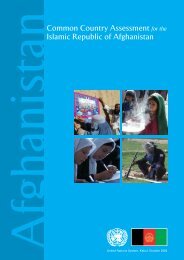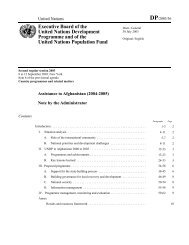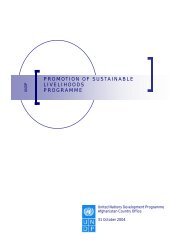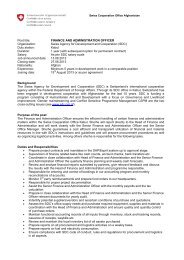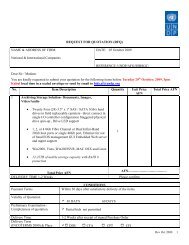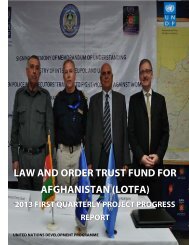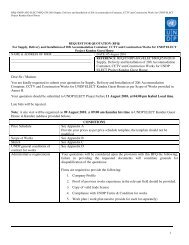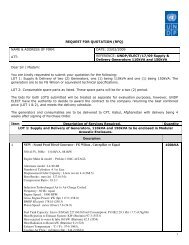Herat Provincial Profile
Herat Provincial Profile
Herat Provincial Profile
Create successful ePaper yourself
Turn your PDF publications into a flip-book with our unique Google optimized e-Paper software.
Regional Rural Economic Regeneration Strategies (RRERS)<br />
GRM<br />
<strong>Provincial</strong> profile for<br />
- <strong>Herat</strong> Province -<br />
1. Natural Resources (ANDS Sector 3)<br />
There are 14 districts in <strong>Herat</strong> province; Names of the districts are Enjil, Guzera, Zandajan, Ghoryan,<br />
Kohsan, Kushk-i-Robat Sangi, Kush-i-Kohna, Gulran, Pashtun Zarghon, Obe, Shesht Sharif, Adraskan,<br />
Shindand and Farsi.<br />
Following natural resources are available in the province which can be exploited for economic regeneration.<br />
1. Development of mines (extracting Oil, Gold, Salt, Lime, Barite , Sulphur and Marble stone mine):<br />
The interviews with different key informants reveal that there are lot of mines and there is good<br />
potential opportunity to invest and exploit these mines for economic regeneration.<br />
2. Cement production: The already existing cement factory in <strong>Herat</strong> is not in production anymore and<br />
by reactivating it can produce a lot of economic regeneration opportunities especially employment.<br />
3. Wind Energy: The high speed wind in three months during summer and then the availability of wind<br />
throughout year can be utilized for sustainable source of energy.<br />
4. Pistachio Forest: Natural pistachio forests are located in Koshk-eKohna district and during past 20<br />
these forests are indiscriminately cut for fuel. There are no protection measures in place and in future<br />
these existing forests need to be protected and plantation of other pistachio forest should be<br />
established especially in Kushk district. Moreover, a lot of medicinal plants like liquorice and black<br />
cumin are found in rural <strong>Herat</strong> and these needs to be exploited on sustainable basis for economic<br />
regeneration.<br />
5. Currently there are no big dams in <strong>Herat</strong> but there is a big potential to construct dams on two<br />
perennial rivers i.e. Harirud and Kabgan rivers thus providing both energy and irrigation water.<br />
Recently work on Salma dam in the province has restarted.<br />
2 . Human Resources<br />
Most of returnees managed to return to the provinces and districts from where they migrated. There is still a<br />
significant proportion of migrated people still living in four camps near <strong>Herat</strong> city:<br />
1. Shaedae Camp accommodating 1350 families.<br />
2. Maslakh Camp accommodating 3466 families.<br />
3. Munarate camp accommodating 500 families and<br />
4. Kamarkalagh Camp accommodating 172 families.<br />
Most of the people living in these camps are internally displaced people or returnees from other countries<br />
mainly Iran and they are not willing to return to their original settlements from where they migrated during<br />
war. They are working as labours in <strong>Herat</strong> or going to Iran for work. Some times they go to Helmand and<br />
Kandahar for labour. Directorate of Immigrating have planned to make a compound for returnees near <strong>Herat</strong><br />
city and have allotted 1000 units of land for constructing of houses for returnees.<br />
In total, there are 587 operational schools in <strong>Herat</strong> city. Out of 587 schools in Heart city 17 are high schools<br />
for boys and 10 high schools for girls. At district level there is 39 high schools for the boys and 4 high<br />
schools for the girls. And total of 437 foundation school also exist in the province (404 for boys and 33 for<br />
girl). Most of the schools have no proper building and furniture and around 30% of students studying in<br />
schools without building and furniture.<br />
3 Agriculture (ANDS Sector 6)<br />
1 of 6
Regional Rural Economic Regeneration Strategies (RRERS)<br />
GRM<br />
3.1 Overview<br />
Both irrigated and rain fed agriculture systems exist in Heart. Northern districts are rain fed (approximately<br />
90%) and central and eastern districts are mostly irrigated (more then 90% of land) .Major source of<br />
irrigation is Hirayrud river which irrigates more than 1000 Ha of land. Other sources of irrigation are springs<br />
and Karizes mainly in remote areas. Recently some farmers have started to bore wells and use ground water<br />
for irrigation. The traditional old mirab systems still exists for regulation of water rights and repair of<br />
extensive irrigation infrastructure.<br />
About 20-30 percent of farmers use tractor and others use bullocks and donkeys for ploughing and mainly<br />
cultivation of traditional crops is still prevalent.<br />
3.2 Crops<br />
Cereal crops like wheat, barley and rice are produced are mainly produced in the province. During last 20<br />
years rice cultivation area has decreased significantly due to scarcity of water. Leguminous crops like pea,<br />
bean, mong and mash are cultivated in irrigated land some time as a second crop. Oil seed crops like sesame<br />
is also cultivated on both rainfed and irrigated land. In past cotton was also a major crop providing cotton for<br />
textile industries and cotton seed for oil industry. But now both these industries are not fully operational and<br />
as a result cotton production has gone down significantly. Vegetables are also produced both for home<br />
consumption and sale and now the market for vegetable production is also growing. <strong>Herat</strong> is also famous for<br />
grapes and resin production. In some of the districts like Ghoryan and Pastun Zargoon saffron cultivation is<br />
also on increase with the support of DACAAR and other organisations.<br />
3.3 Livestock<br />
People mainly rely on livestock and its products to support their families. Farm yard manure is mainly used<br />
for crop production. Sheep, goats and camels are mainly found in remote rainfed areas while in flat and<br />
irrigated land mainly cows and donkeys are kept. Private sector on a smaller scale is active in milk<br />
production and processing.<br />
3.4 Fisheries<br />
Some private fish ponds exist in the province and in future there is a great potential for expanding this sector<br />
as it has good marketing opportunities in <strong>Herat</strong>. Now mainly imported fish is fulfilling the local demand.<br />
3.5 Land tenure<br />
According to the information provided by Agriculture Directorate, <strong>Herat</strong> approximately 30-40 % are small<br />
land owners having 1-5 Jeribs of land, 50-40% are medium land owners having 6-30 Jeribs of land while<br />
around 20% farmers are big farmers having more than 30 Jeribs of land.<br />
3.6 Agricultural support services and input supplies<br />
Agriculture Directorate is mainly responsible for providing support services and inputs to the farmers in the<br />
province but the extent of their services is not very extensive. Inputs like seed, fertilizer, pesticide and<br />
vaccine are provided by the Directorate to some farmers. Some inputs and technical support is also provided<br />
by NGOs working in different districts of the province.<br />
3.7 Agricultural structures (farmer groups/organisations/larger farmers etc)<br />
There are 50 agriculture cooperatives working in <strong>Herat</strong> province. Many other associations and farmers<br />
groups like Horticulture Association, Livestock owners Association, Saffron Associations, Nursery<br />
producers Association, improved seed producers Association also exist in the province. All of these<br />
associations are active but still needs capacity building and support to be fully functional.<br />
2 of 6
Regional Rural Economic Regeneration Strategies (RRERS)<br />
GRM<br />
3.8 Agriculturally related businesses<br />
Some groups of people/Associations and companies are engaged in primary processing and exports of fruits,<br />
vegetables, seeds, herbal plants, livestock products, handicrafts etc. For example businesses like jam<br />
production, tomato past production, liquorice processing and export, pistachio and other nuts processing and<br />
export, diary processing, skin and intestine processing and export, saffron processing and export, handicraft<br />
production and export, import of Agriculture imports are operational in the province.<br />
4 Other business activities (ANDS Sector 8)<br />
<strong>Herat</strong> is the hub for business activities mainly due to its accessibility to Iran and Turkmanistan as both the<br />
countries has borders with the province. A lot of import and export is going on between <strong>Herat</strong> and these two<br />
countries. One of the growing businesses is the import of the cars from Dubai through Iran which are then<br />
supplied to the rest of country.<br />
Handicraft, carpets and rugs production business is also a major activity in the province. The textile, silk, oil<br />
and cements factories exist in the provincial centre but are not fully operation and has the potential to be<br />
revitalised for economic regeneration. Other small businesses like shops, workshops and IT industry is also<br />
growing in the provincial centre.<br />
5 Security (ANDS Sector 1)<br />
In general security is good in <strong>Herat</strong> province compared to other parts of the country.<br />
6 Physical infrastructure (ANDS Sector 8)<br />
The construction of Salma dam on Harirud River in Chest-e-Sharif has restarted recently. Work on<br />
asphalting two main roads i.e. from <strong>Herat</strong> to Qandahar and <strong>Herat</strong> to Badghis is going on.<br />
7 Institutional constraints (ANDS Sector 8)<br />
Low financial and human capacity in government departments is a major institutional constraint. Poppy<br />
traders may also affect to create obstacles in implementation of development activities<br />
8 Credit<br />
NGO’s like BRAC, DACAAR, FINCA and AKF.<br />
9 Stakeholders<br />
.<br />
Name of Stake holders Ranking Status<br />
National authorities<br />
<strong>Provincial</strong> council 1 They are interested in development activities and can influence<br />
any development activities. PC has the will to speed up to the<br />
development process but they do not have enough human and<br />
financial resources to do it. The community have more faith in them<br />
as elected representatives. In principle any development plan should<br />
be approved by them in provincial level.<br />
Regional and local<br />
All Government Sectors 1 All government sectors are active and could play an important<br />
role in implementing of development activities. But majority of them<br />
need capacity building and access to funds<br />
Cooperatives and Associations 2 50 cooperatives and 20 associations or farmer groups are active<br />
in implementing development activities. Most of them are in infancy<br />
and need capacity building to function efficiently.<br />
NGO’s 1 Many NGO’s and INGO’s are active in <strong>Herat</strong> Areas and some of<br />
3 of 6
Regional Rural Economic Regeneration Strategies (RRERS)<br />
GRM<br />
them have Zonal offices in <strong>Herat</strong> having activities in western<br />
provinces. NGOs and INGOs are playing a pivotal role in<br />
development as they have access to talented professional and funds<br />
to implement their plans.<br />
Civil Societies 2 Many civil Society organizatins exist in <strong>Herat</strong>, like Skills<br />
Shura’s, professional shura’s, etc. but they need capacity building to<br />
function properly.<br />
10 Summary of key potential development opportunities:<br />
Following potential are available in the province:<br />
1. There is multi-sector development possible.<br />
2. Mines like Oil, lime, cool, cement, Stone marble , Gold Mine in Chesht-e-Sharif, Salt mine,<br />
Berite mine, Sulfur mine extraction<br />
3. Energy generation from water through construction of Salma dam and Kabgan dam.<br />
4. Water diversion for irrigation through construction of Canals from Hirayrud and Kabgan rivers.<br />
5. Wind and solar energy utilization<br />
6. Orchard development<br />
7. Fruits production, processing and marketing.<br />
8. Vegetable production, processing and marketing<br />
9. Pistachio extension.<br />
10. Saffron production, processing and marketing<br />
11. Oil seed crops improvements<br />
12. Cotton processing factories .<br />
13. Textile factories development.<br />
14. Silk Production, processing and marketing.<br />
15. Livestock improvement<br />
16. Diary processing and marketing<br />
17. Handicrafts development<br />
18. Fisheries, development.<br />
19. Industrial Association development<br />
20. Trading development.<br />
21. Micro dams.<br />
22. Business sector development.<br />
23. Poultry development<br />
24. Associations and Cooperatives, development.<br />
25. Ports opportunities developments<br />
26. Tourism<br />
4 of 6
Regional Rural Economic Regeneration Strategies (RRERS)<br />
Annexes<br />
GRM<br />
Annex 1: Summary of the main development activities in the province<br />
Programmes/Projects Agency/Donor Approx<br />
Value US $<br />
No Completed.<br />
1 50 Cooperatives established Govt. NA<br />
2 20 Associations/interest Various<br />
NA<br />
groups farmed<br />
3 100 schools constructed Various NA<br />
4 59 km road asphalted Govt. NA<br />
5 3000 MT improved seed Govt.<br />
NA<br />
produced<br />
6 Enjil canal structures Irrigating department<br />
NA<br />
constructed<br />
7 Some structures on Guzaera Irrigation department<br />
NA<br />
canal completed<br />
8 Sabars Bridge in Chsht-e- USAID<br />
Sharif<br />
9 Diversion Dam in Akhta chi Irrigation department<br />
Gulran<br />
10 Improvement of Araperda<br />
canals in Obe district<br />
Irrigation department<br />
Ongoing/planned projects<br />
1. Work on four canal in Pashtun Govt.<br />
NA<br />
Zarghon<br />
2. Work on one canal in Obe Gobvt.<br />
NA<br />
districts<br />
3. Diary processing FAO NA<br />
4 Alternative livelihood FAO NA<br />
5 Livelihood program DACAAR NA<br />
Comments<br />
significance<br />
etc.<br />
6 Micro Credit DACAAR, BRAC, FINCA, NA<br />
AKF<br />
7 Food for work pojects WFP NA<br />
Annex 2: Sources of data and relevant reports:<br />
Data was collected from nine major government departments and NGos working in area<br />
Annex 3: Working methodology used:<br />
Building upon the experience of the DACAAR staff in the province, additional information was collected<br />
from officials of key government departments. The purpose of the RRERS study was discussed with the<br />
officials of MRRD and their input and suggestions were incorporated in the provincial profile.<br />
5 of 6
Regional Rural Economic Regeneration Strategies (RRERS)<br />
GRM<br />
Annex 4: List of persons/agencies visited/contacted<br />
Name Position/agency Topic discussed Date<br />
Mr. Aqa Mohammad <strong>Provincial</strong> Director of All 25.09.06<br />
Saddiqi<br />
MRRD in <strong>Herat</strong> province<br />
Eng. Hamiddullah Deputy <strong>Provincial</strong> All 05.10.06<br />
Director of MRRD in<br />
<strong>Herat</strong> province<br />
Eng Wakil Ahmad MRRD/NABDP Regional All 05.10.06<br />
Saddiqi<br />
Advisor<br />
Eng. Ali Ahmad<br />
Mansoori<br />
Director of Economic Natural resources, ongoing,<br />
completed ,planned projects,<br />
07.10.006<br />
Mr. Ab. Zahir Faiz<br />
Zada<br />
Mr. Jamshid Azizi<br />
Nikjo<br />
Mr. Fazel Ahmad<br />
Zakeri<br />
Haji Ismael<br />
Haiderzada<br />
Haji Sadduddin<br />
Mr. Basir Ahmad<br />
Tahiri<br />
Telephone<br />
conversation<br />
Aziza<br />
Deputy of <strong>Provincial</strong><br />
council<br />
<strong>Provincial</strong> council<br />
Rehabilitation,<br />
Development and<br />
planning committee<br />
Director of Irrigation<br />
Department<br />
Director of Agriculture<br />
department<br />
Deputy Director of<br />
Agriculture department<br />
Deputy of Education<br />
Directorate<br />
Director of Immigration<br />
Department<br />
Social Organizer<br />
DACAAR <strong>Herat</strong><br />
stakeholders and security<br />
Natural resources, ongoing,<br />
completed ,planned projects,<br />
stakeholders and security<br />
Natural resources, ongoing,<br />
completed ,planned projects,<br />
stakeholders and security<br />
07.10.006<br />
07.10.006<br />
Irrigation System 07.10.006<br />
Agriculture 08.10.006<br />
Agriculture 08.10.006<br />
Human Resources 12.10.06<br />
Human Resource 12.10.006<br />
Human Resource 12.10.06<br />
Annex 5: <strong>Provincial</strong> summary of socio economic data: NA<br />
6 of 6



